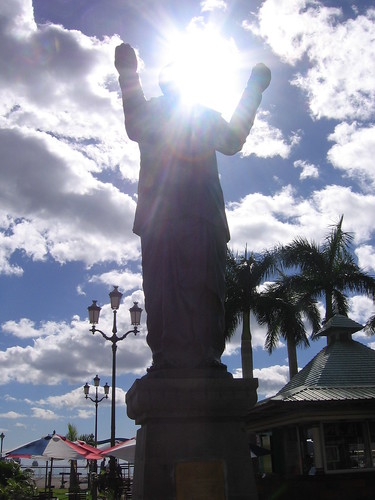Converting to the unconverted
Just back from a trip to Amsterdam, where the newly embedded Victor S and I took in a gig by The Earlies at the Paradiso and sampled the wares of the city's only artisanal brewery, Brouwerie 't IJ (full details on our next podcast).
The Paradiso is the third deconsecrated church I have been to that is now being used as a nightclub/live music venue: the first was Birmingham's answer to Le Corbeau, the Moseley Dance Centre back in 1994 (Doop by Doop was top of the charts!); the second was Mass in Brixton, where 808 State played a wicked live set in 2000. The Paradiso is probably the most impressive of the three, although The Earlies and support act Merz (back from contractual limbo), were snuck away in the small hall upstairs, rather than in the fabulous main arena.
Other well-known music venues in former churches include Belfast's Empire Music Hall and the Limelight nighclubs of London (now a Walkabout) and New York, uber hip in the 80s.
The conversion of synagogues into venues for sweaty musical abandon is also a well-documented tradition: The well-known 1930s dance, the Big Apple, is said to have originated in an abandoned synagogue that had been turned into a juke joint; Wood's Minstrel Hall, a converted synagogue just off Broadway, featured minstrel shows between 1862 and 1881, and was possibly the venue for the first ever musical comedy, Harrigan and Hart's 'Mulligan Guard Picnic' (1878).
By contrast, there doesn't appear to be a single example of a mosque being converted into a venue for music and dancing (at least not one that is documented in English on the worldwide web). Googling "nightclub, 'converted mosque'" instead brings up a series of articles about radical cleric Abu Hamza, recently jailed in the UK for seven years for racial hatred and incitement to murder, who worked as a nightclub bouncer in Brighton in the early 1980s(!)
The Paradiso is the third deconsecrated church I have been to that is now being used as a nightclub/live music venue: the first was Birmingham's answer to Le Corbeau, the Moseley Dance Centre back in 1994 (Doop by Doop was top of the charts!); the second was Mass in Brixton, where 808 State played a wicked live set in 2000. The Paradiso is probably the most impressive of the three, although The Earlies and support act Merz (back from contractual limbo), were snuck away in the small hall upstairs, rather than in the fabulous main arena.
Other well-known music venues in former churches include Belfast's Empire Music Hall and the Limelight nighclubs of London (now a Walkabout) and New York, uber hip in the 80s.
The conversion of synagogues into venues for sweaty musical abandon is also a well-documented tradition: The well-known 1930s dance, the Big Apple, is said to have originated in an abandoned synagogue that had been turned into a juke joint; Wood's Minstrel Hall, a converted synagogue just off Broadway, featured minstrel shows between 1862 and 1881, and was possibly the venue for the first ever musical comedy, Harrigan and Hart's 'Mulligan Guard Picnic' (1878).
By contrast, there doesn't appear to be a single example of a mosque being converted into a venue for music and dancing (at least not one that is documented in English on the worldwide web). Googling "nightclub, 'converted mosque'" instead brings up a series of articles about radical cleric Abu Hamza, recently jailed in the UK for seven years for racial hatred and incitement to murder, who worked as a nightclub bouncer in Brighton in the early 1980s(!)

0 Comments:
Post a Comment
<< Home